Performance Evaluation of a Biological Pre-Treatment Coupled with the Down-Flow Expanded Granular Bed Reactor (DEGBR) for Treatment of Poultry Slaughterhouse Wastewater
Abstract
:1. Introduction
2. Materials and Methods
2.1. Experimental Set-Up
2.2. Operating Conditions
Pre-Treatment and Sample Preparation
2.3. DEGBR Set-Up, Operation and Inoculation
2.4. Sample and Analytical Methods
Statistical Analysis
2.5. Procedure Followed for Study
3. Results
3.1. Biological Pretreatment Performance
3.1.1. FOG Removal
3.1.2. COD Removal
3.1.3. TSS Removal
3.2. The Performance of the DEBGR
3.2.1. The Effect of pH, Temperature and VFA/Alkalinity on the DEGBR Performance
3.2.2. Biogas Production
3.3. Overall Performance of the DEGBR
An in-Depth Analysis of Pre-Treatment Unit-DEGBR Performance Parameters
3.4. A Comparison of Product Parameters with the City of Cape Town Specifications
4. Limitations and Future Research Direction
5. Conclusions
Author Contributions
Funding
Data Availability Statement
Acknowledgments
Conflicts of Interest
References
- Bustillo-Lecompte, C.; Mehrvar, M. Slaughterhouse Wastewater: Treatment, Management and Resource Recovery. Phys. Chem. Wastewater Treat. Resour. Recovery 2017, 153–155. [Google Scholar] [CrossRef] [Green Version]
- Yaakob, M.A.; Maya, R.; Radin, S.; Saeed, A.A.; Hashim, A.; Kassim, M. Characteristics of Chicken Slaughterhouse Wastewater. AIDIC 2018, 63, 637–642. [Google Scholar]
- Valta, K.; Kosanovic, T.; Malamis, D.; Moustakas, K.; Loizidou, M. Overview of water usage and wastewater management in the food and beverage industry. Desalination Water Treat. 2015, 53, 3335–3347. [Google Scholar] [CrossRef]
- Barrera, M.; Mehrvar, M.; Gilbride, K.A.; McCarthy, L.H.; Laursen, A.E.; Bostan, V.; Pushchak, R. Photolytic treatment of organic constituents and bacterial pathogens in secondary effluent of synthetic slaughterhouse wastewater. Chem. Eng. Res. Des. 2012, 90, 1335–1350. [Google Scholar] [CrossRef]
- Mannina, G. Frontiers in Wastewater Treatment and Modelling: FICWTM; Springer International Publishing: Cham, Switzerland, 2017; pp. 229–230. [Google Scholar]
- De Nardi, I.R.; Del Nery, V.; Amorim, A.K.B.; dos Santos, N.G.; Chimenes, F. Performances of SBR, chemical-DAF and UV disinfection for poultry slaughterhouse wastewater reclamation. Desalination 2011, 269, 184–189. [Google Scholar] [CrossRef] [Green Version]
- Debik, E.; Coskun, T. Bioresource Technology Use of the Static Granular Bed Reactor (SGBR) with anaerobic sludge to treat poultry slaughterhouse wastewater and kinetic modeling. Bioresour. Technol. 2009, 100, 2777–2782. [Google Scholar] [CrossRef] [PubMed]
- Meneses, Y.E.; Stratton, J.; Flores, R.A. Water reconditioning and reuse in the food processing industry: Current situation and challenges. Trends Food Sci. Technol. 2017, 61, 72–79. [Google Scholar] [CrossRef]
- Dlamini, D.N.; Basitere, M.; Karabo, S.; Ntwampe, O. Current and Functional Reactor Designs in Poultry Slaughterhouse Wastewater Treatment. In Proceedings of the 16th SOUTH AFRICA Int’l Conference on Agricultural, Chemical, Biological & Environmental Sciences (ACBES-19), Johannesburg, South Africa, 18–19 November 2019; pp. 295–300. Available online: http://earbm.org/proceedingspdf.php?id=61 (accessed on 20 February 2021).
- Park, J.; Oh, J.H.; Ellis, T.G. Evaluation of an on-site pilot static granular bed reactor (SGBR) for the treatment of slaughterhouse wastewater. Bioprocess. Biosyst. Eng. 2012, 35, 459–468. [Google Scholar] [CrossRef] [PubMed]
- Njoya, M.; Basitere, M.; Ntwampe, S.K.O. Treatment of poultry slaughterhouse wastewater using a down-flow expanded granular bed reactor. Water Pract. Technol. 2019, 14, 549–559. [Google Scholar] [CrossRef]
- Mao, C.; Feng, Y.; Wang, X.; Ren, G. Review on research achievements of biogas from anaerobic digestion. Renew. Sustain. Energy Rev. 2015, 45, 540–555. [Google Scholar] [CrossRef]
- Li, D.; Ganczarczyk, J. Research Journal of the Water Pollution Control Federation. Res. J. Water Pollut. Control. Fed. 1991, 63, 806–814. [Google Scholar]
- Del Nery, V.; Pozzi, E.; Damianovic, M.H.R.Z.; Domingues, M.R.; Zaiat, M. Granules characteristics in the vertical profile of a full-scale upflow anaerobic sludge blanket reactor treating poultry slaughterhouse wastewater. Bioresour. Technol. 2008, 99, 2018–2024. [Google Scholar] [CrossRef] [PubMed]
- Baird, R.; Bridgewater, L. Standard Methods for the Examination of Water and Wastewater, 23rd ed.; American Public Health Association: Washington, DC, USA, 2017; pp. 1–1546. [Google Scholar]
- Natassia, J.C.; Benedito, M.G.; Simone, D.G.; Ana, P.R.S.; Glaucia, M.P. Use of biosurfactant surfactin produced from cassava wastewater for anaerobic treatment of effluent from a poultry slaughterhouse. Afr. J. Biotechnol. 2017, 5, 224–231. [Google Scholar] [CrossRef] [Green Version]
- City of Cape Town, SA. Wastewater and Industrial Effluent by-Laws. 2013. Available online: https://openbylaws.org.za/za-cpt/act/by-law/2013/wastewater-industrial-effluent/eng/ (accessed on 20 February 2021).
- Rusten, B.; Siljudalen, J.G.; Wien, A.; Eidem, D. Biological pretreatment of poultry processing wastewater. Water Sci. Technol. 1998, 38, 19–28. [Google Scholar] [CrossRef]
- Del Nery, V.; de Nardi, I.R.; Damianovic, M.H.R.Z.; Pozzi, E.; Amorim, A.K.B.; Zaiat, M. Long-term operating performance of a poultry slaughterhouse wastewater treatment plant. Resour. Conserv. Recycl. 2007, 50, 102–114. [Google Scholar] [CrossRef]
- Rinquest, Z.; Basitere, M.; Ntwampe, S.K.O.; Njoya, M. Poultry slaughterhouse wastewater treatment using a static granular bed reactor coupled with single stage nitrification-denitrification and ultrafiltration systems. J. Water Process. Eng. 2019, 29, 100778. [Google Scholar] [CrossRef]
- Ergofito. Poultry Farming, in Cape Town. 2019, p. 4. Available online: https://www.ergofito.co.za/application/Grease-Fats-Overview (accessed on 12 May 2021).
- Dong, C.J.; Pan, Q.Y.; Lu, H.Y.; Sun, Y.Q. Rapidly Start-Up and Performance of the EGSB Reactor Treating Actual Coking Wastewater when Seeded with Digestion Sludge. Adv. Mater. Res. 2013, 726–731, 2567–2571. [Google Scholar] [CrossRef]
- Rajakumar, R.; Meenambal, T.; Banu, J.R.; Yeom, I.T. Treatment of poultry slaughterhouse wastewater in upflow anaerobic filter under low upflow velocity. Int. J. Environ. Sci. Technol. 2011, 8, 149–158. [Google Scholar] [CrossRef] [Green Version]
- Meyo, H.B.; Njoya, M.; Basitere, M.; Karabo, S.; Ntwampe, O.; Kaskote, E. Treatment of Poultry Slaughterhouse Wastewater (PSW) Using a Pretreatment Stage, an Expanded Granular Sludge Bed Reactor (EGSB), and a Membrane Bioreactor (MBR). Membranes 2021, 11, 345. [Google Scholar] [CrossRef]
- Elefsiniotis, P.; Wareham, D.G.; Oldham, W.K. Particulate Organic Carbon Solubilization in an Acid-Phase Upflow Anaerobic Sludge Blanket System. Environ. Sci. Technol. 2002, 30, 1508–1514. [Google Scholar] [CrossRef]
- Burgess, J.E.; Pletschke, B.I. Hydrolytic enzymes in sewage sludge treatment: A mini-review. Water 2008, 34, 343–349. [Google Scholar] [CrossRef] [Green Version]
- Meng, Y.; Luan, F.; Yuan, H.; Chen, X.; Li, X. Bioresource Technology Enhancing anaerobic digestion performance of crude lipid in food waste by enzymatic pretreatment. Bioresour. Technol. 2017, 224, 48–55. [Google Scholar] [CrossRef]
- Zehnder, A.J.B.; Gujer, W. Conversion processes in anaerobic digestion. Water Sci. Technol. 1983, 127–167. [Google Scholar] [CrossRef]
- Majd, S.S.; Abdoli, M.A.; Karbassi, A.; Pourzamani, H.R.; Rezaee, M. Effect of physical and chemical operating parameters on anaerobic digestion of manure and biogas production: A review. J. Environ. Health Sustain. Dev. 2017, 1, 235–247. [Google Scholar]
- Park, J.; Oh, J.H.; Lally, M.F.; Hobson, K.L.; Ellis, T.G. Static Granular Bed Reactor (SGBR) Treatment of Industrial Wastewater. Water Environ. Fed. 2009, 4165–4175. [Google Scholar] [CrossRef]
- Del Nery, V.; Damianovic, M.H.Z.; Moura, R.B.; Pozzi, E.; Pires, E.C.; Foresti, E. Poultry slaughterhouse wastewater treatment plant for high quality effluent. Water Sci. Technol. 2015, 2, 309–316. [Google Scholar] [CrossRef]
- Barana, A.C.; Lopes, D.D.; Martins, T.H.; Pozzi, E.; Damianovic, M.H.R.Z.; Del Nery, V.; Foresti, E. Nitrogen and organic matter removal in an intermittently aerated fixed-bed reactor for post-treatment of anaerobic effluent from a slaughterhouse wastewater treatment plant. J. Environ. Chem. Eng. 2013, 3, 453–459. [Google Scholar] [CrossRef]
- Bustillo-Lecompte, C.F.; Mehrvar, M. Treatment of actual slaughterhouse wastewater by combined anaerobic–aerobic processes for biogas generation and removal of organics and nutrients: An optimization study towards a cleaner production in the meat processing industry. J. Clean. Prod. 2017, 141, 278–289. [Google Scholar] [CrossRef]
- Dlangamandla, C.; Ntwampe, S.K.O.; Basitere, M. A bioflocculant-supported dissolved air flotation system for the removal of suspended solids, lipids and protein matter from poultry slaughterhouse wastewater. Water Sci. Technol. 2018, 78, 452–458. [Google Scholar] [CrossRef] [PubMed]
- Park, H.J.; Chon, J.W.; Lim, J.S.; Seo, K.H.; Kim, Y.J.; Heo, E.J.; Moon, J.S. Prevalence Analysis and Molecular Characterization of Salmonella at Different Processing Steps in Broiler Slaughter Plants in South Korea. J. Food Sci. 2015, 12, 2822–2826. [Google Scholar] [CrossRef] [PubMed]
- Basitere, M.; Njoya, M.; Rinquest, Z.; Ntwampe, S.K.O.; Sheldon, M.S. Performance evaluation and kinetic parameter analysis for static granular bed reactor (SGBR) for treating poultry slaughterhouse wastewater at mesophilic condition. Water Pract. Technol. 2019, 14, 259–268. [Google Scholar] [CrossRef]
- Damasceno, F.R.C.; Cavalcanti-Oliveira, E.D.; Kookos, I.K.; Koutinas, A.A.; Cammarota, M.C.; Freire, D.M.G. Treatment of wastewater with high fat content employing an enzyme pool and biosurfactant: Technical and economic feasibility. Braz. J. Chem. Eng. 2018, 35, 531–542. [Google Scholar] [CrossRef] [Green Version]
- Environmental, Health, and Safety (EHS). Guidelines Poultry Production, World Bank Group. 2007. Available online: https://documents1.worldbank.org/curated/en/937061486569846211/text/112695-WP-ENGLISH-Poultry-Production-PUBLIC.txt (accessed on 17 May 2021).
- Sheldon, M.S.; Erdogan, I.G. Multi-stage EGSB/MBR treatment of soft drink industry wastewater. Chem. Eng. J. 2016, 285, 368–377. [Google Scholar] [CrossRef]
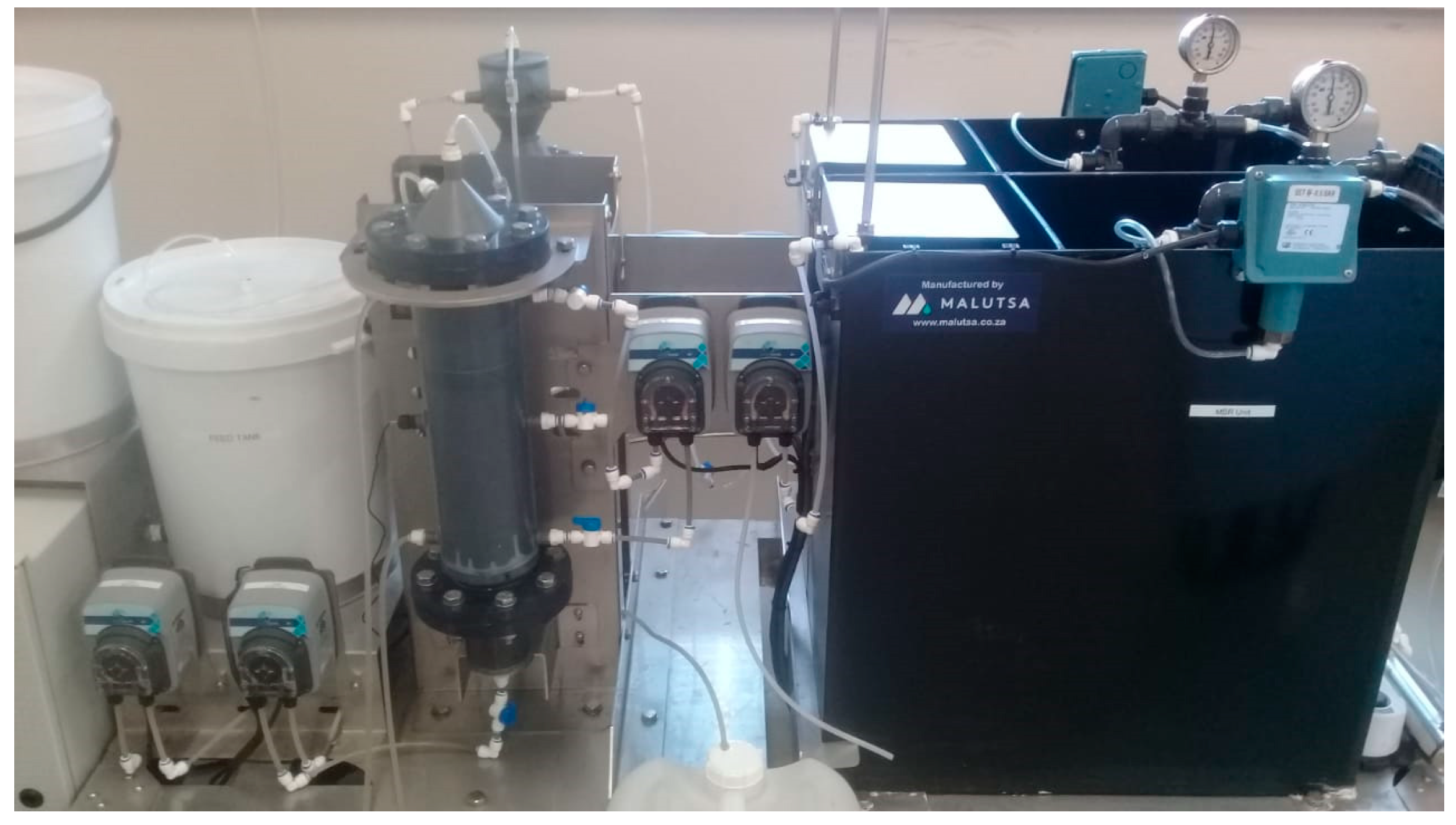

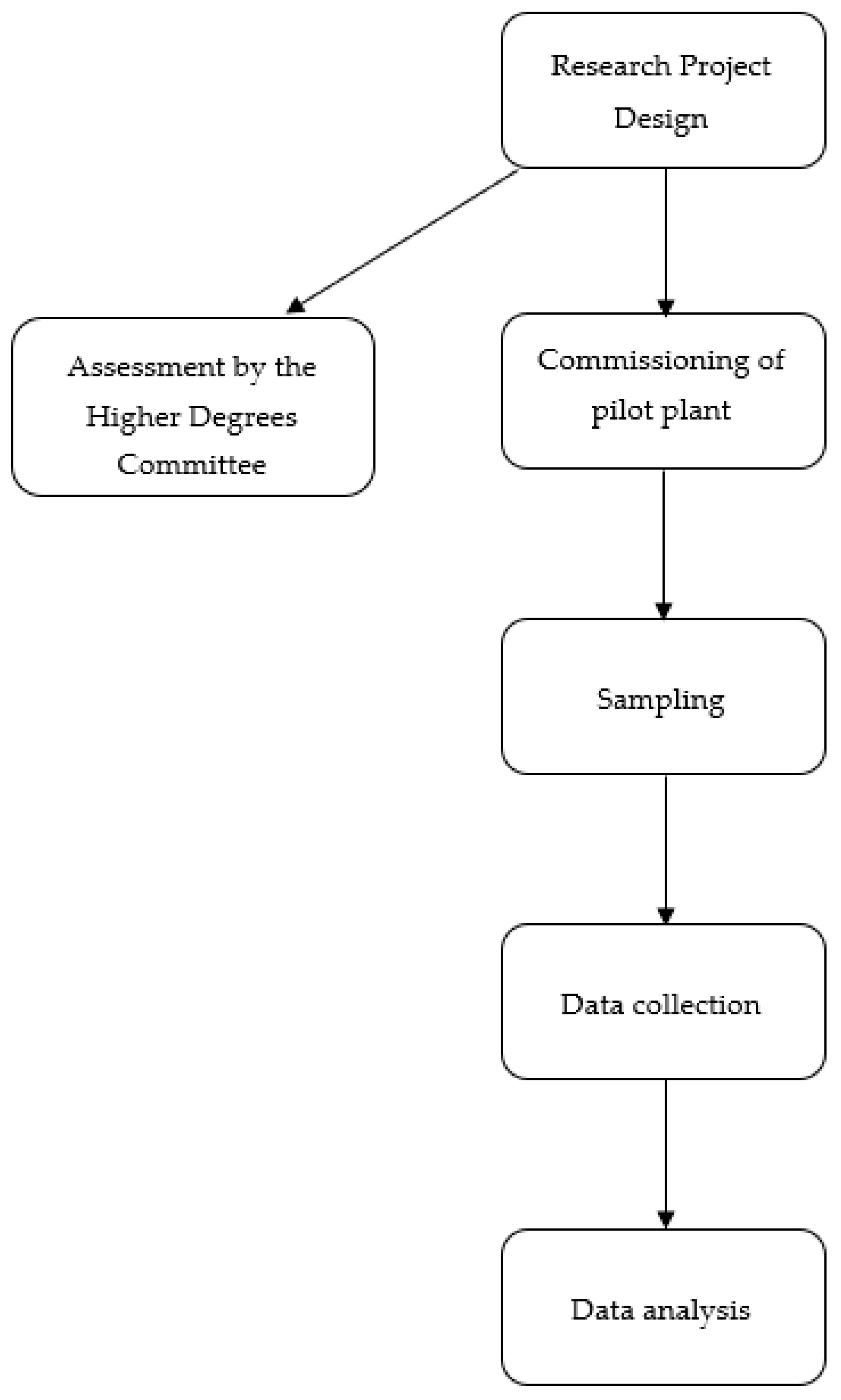
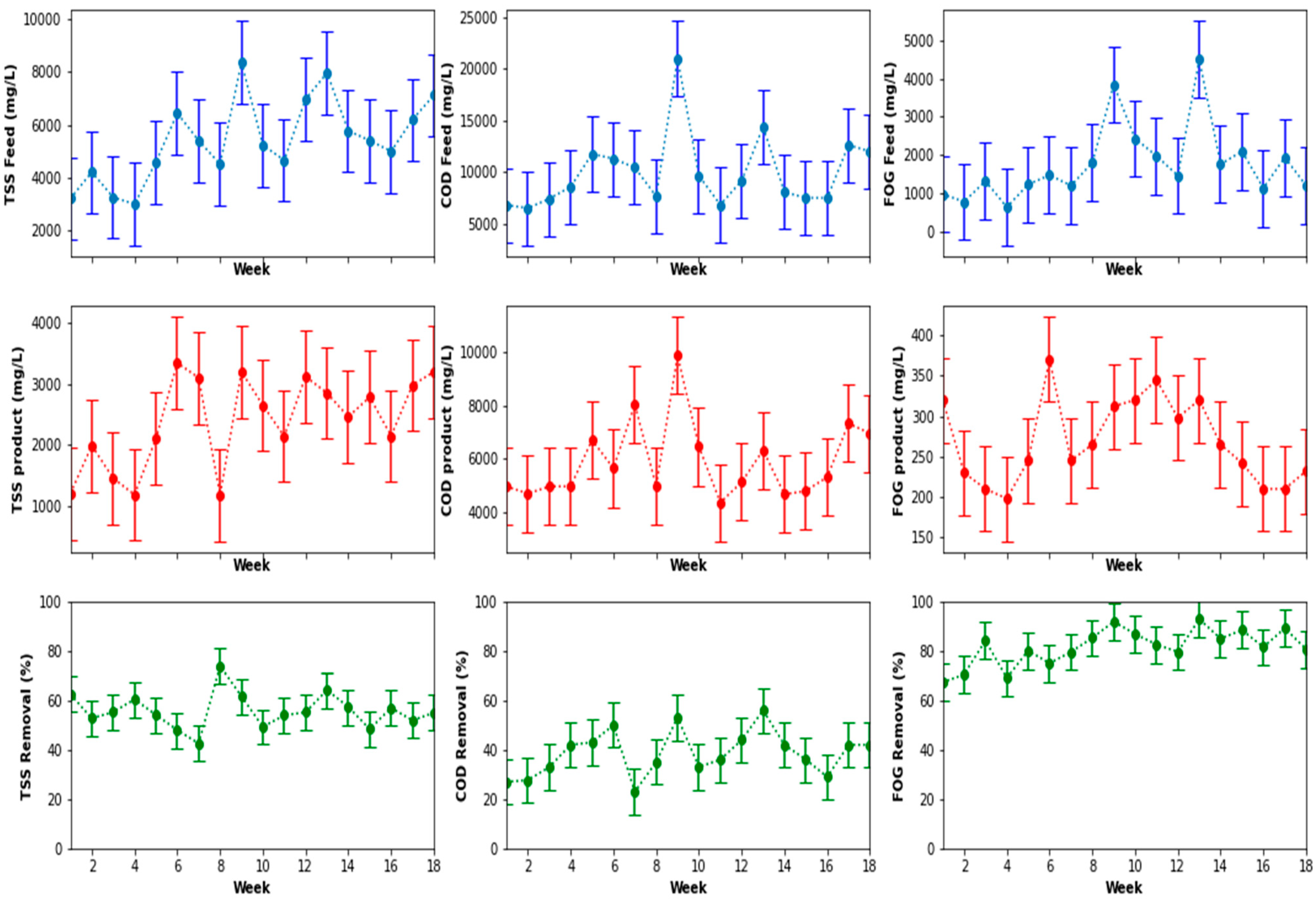

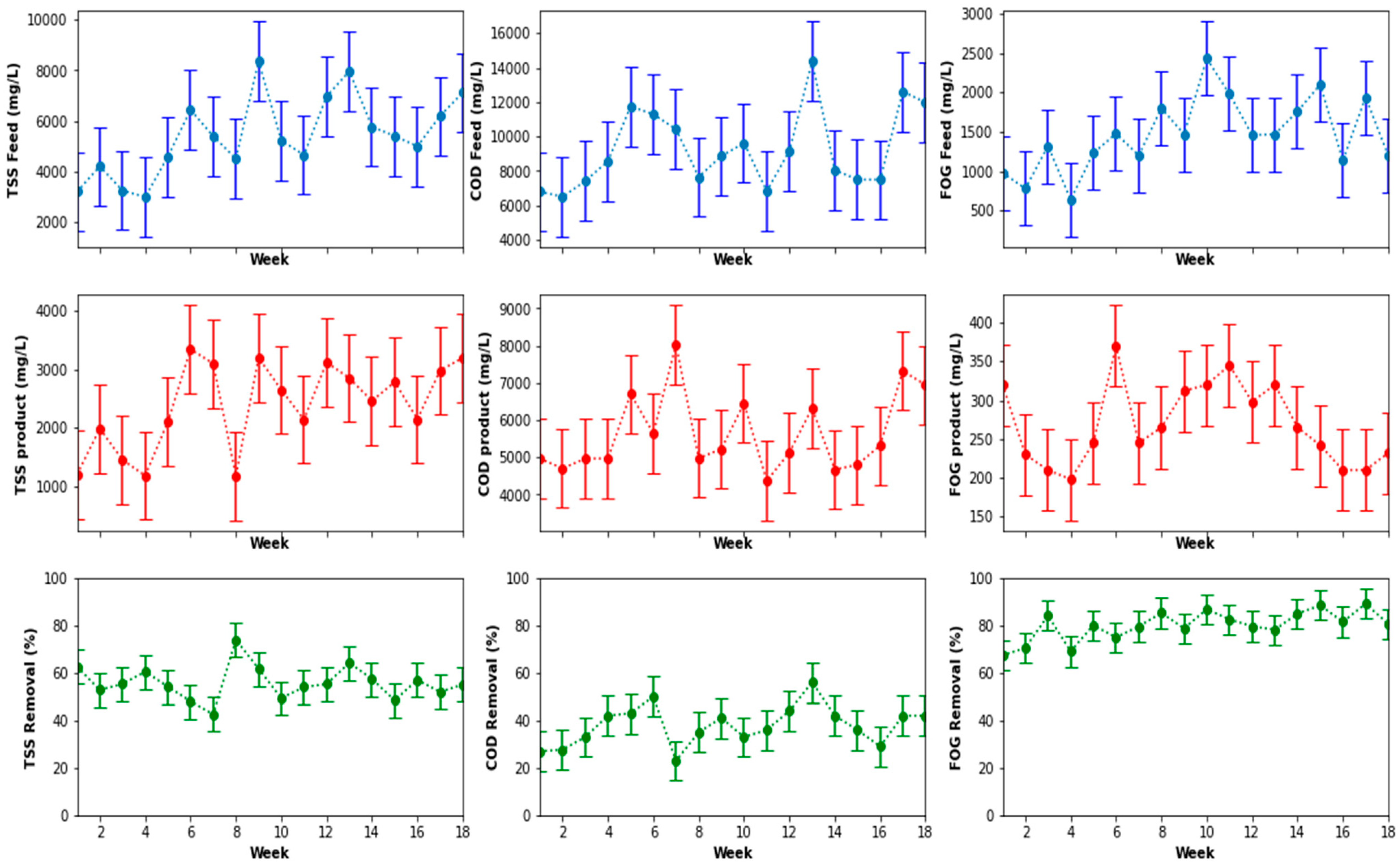
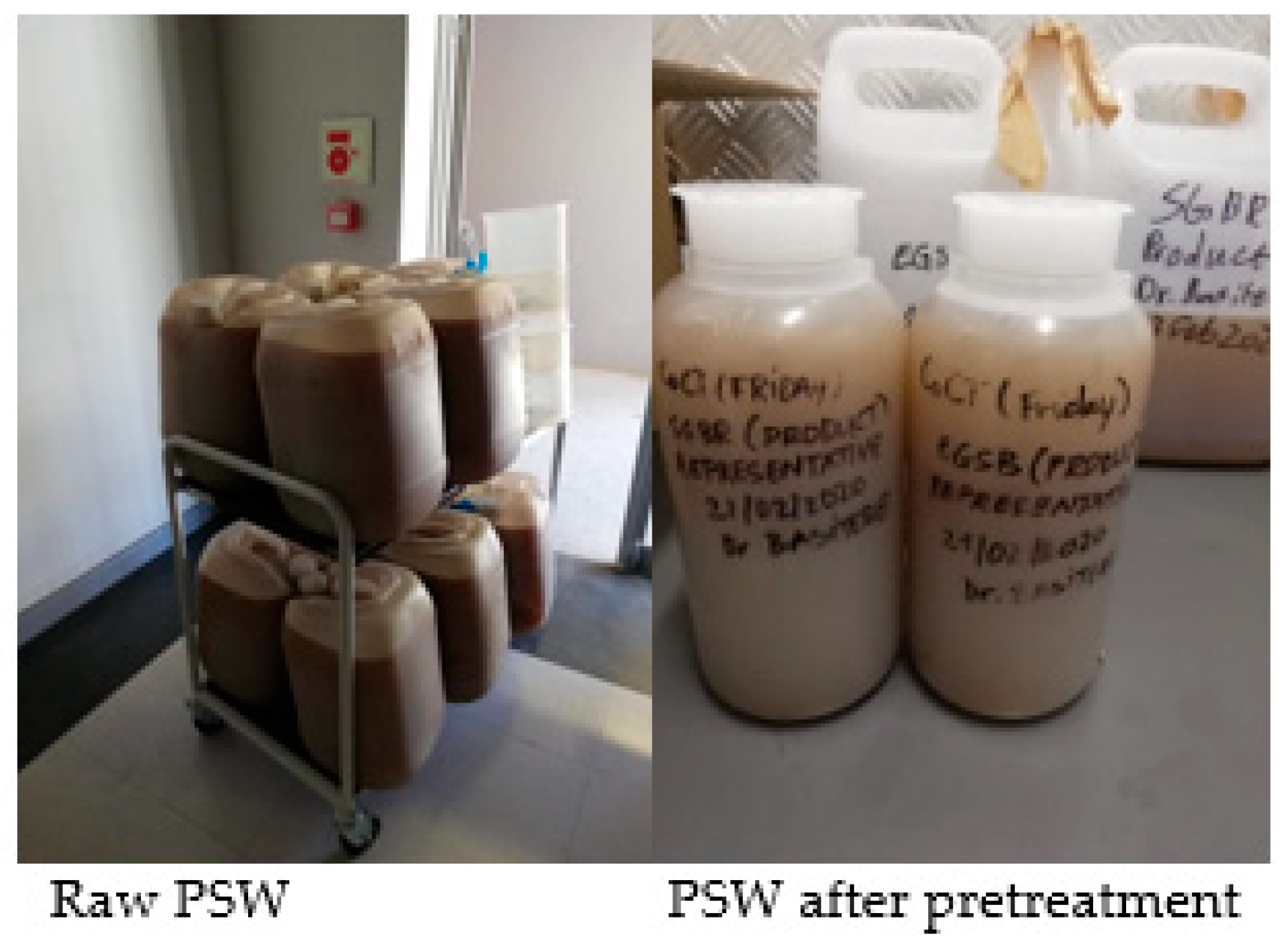


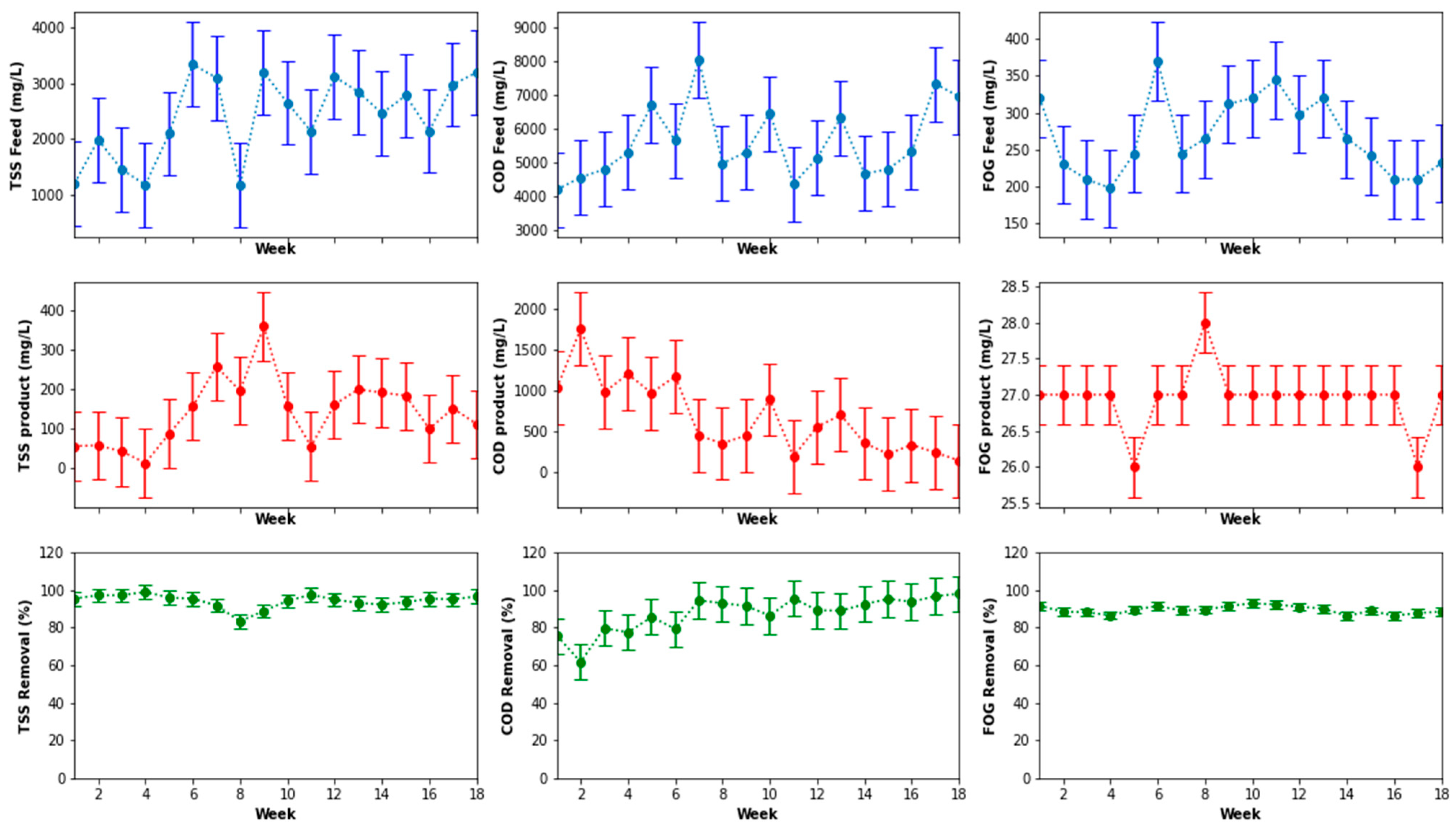
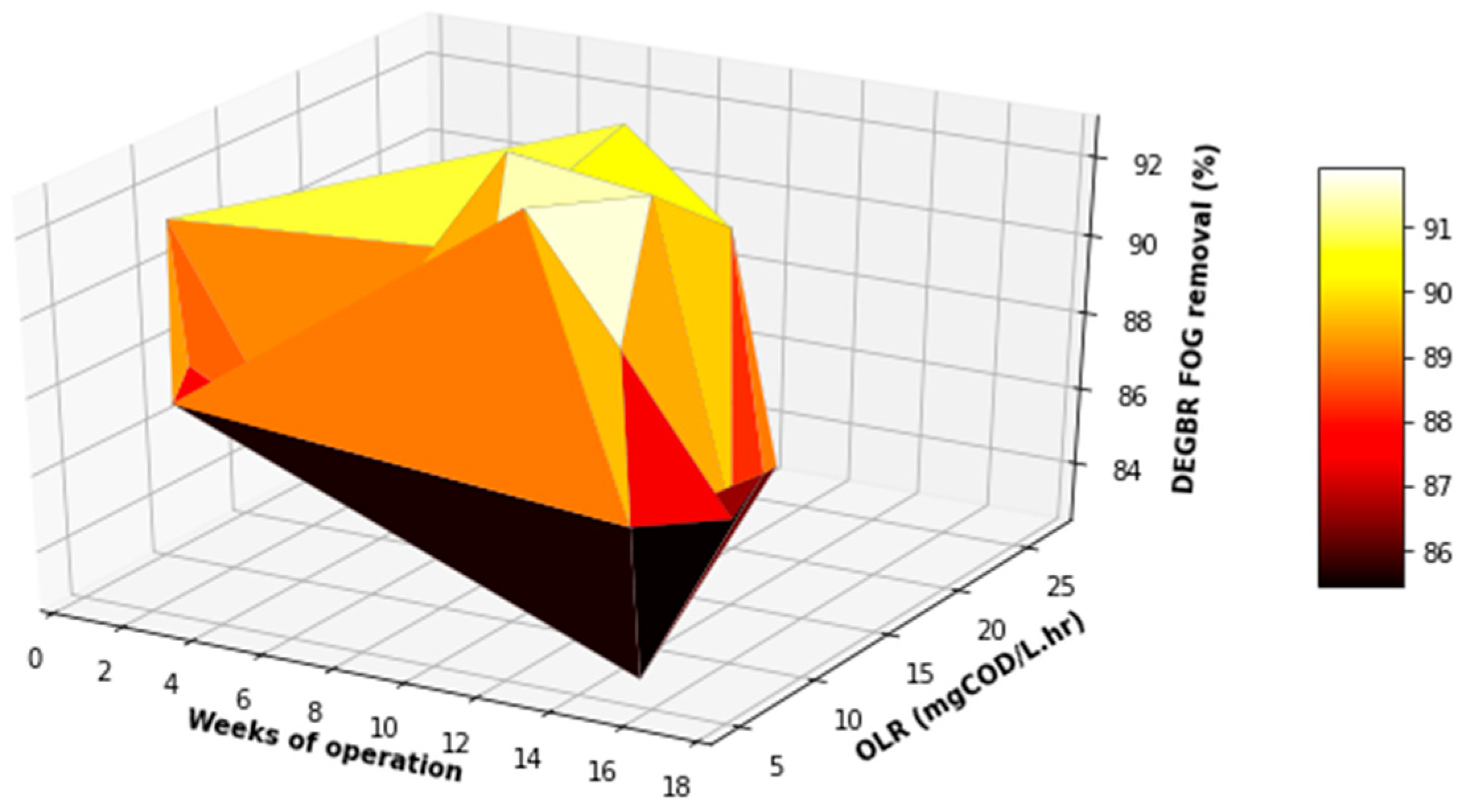
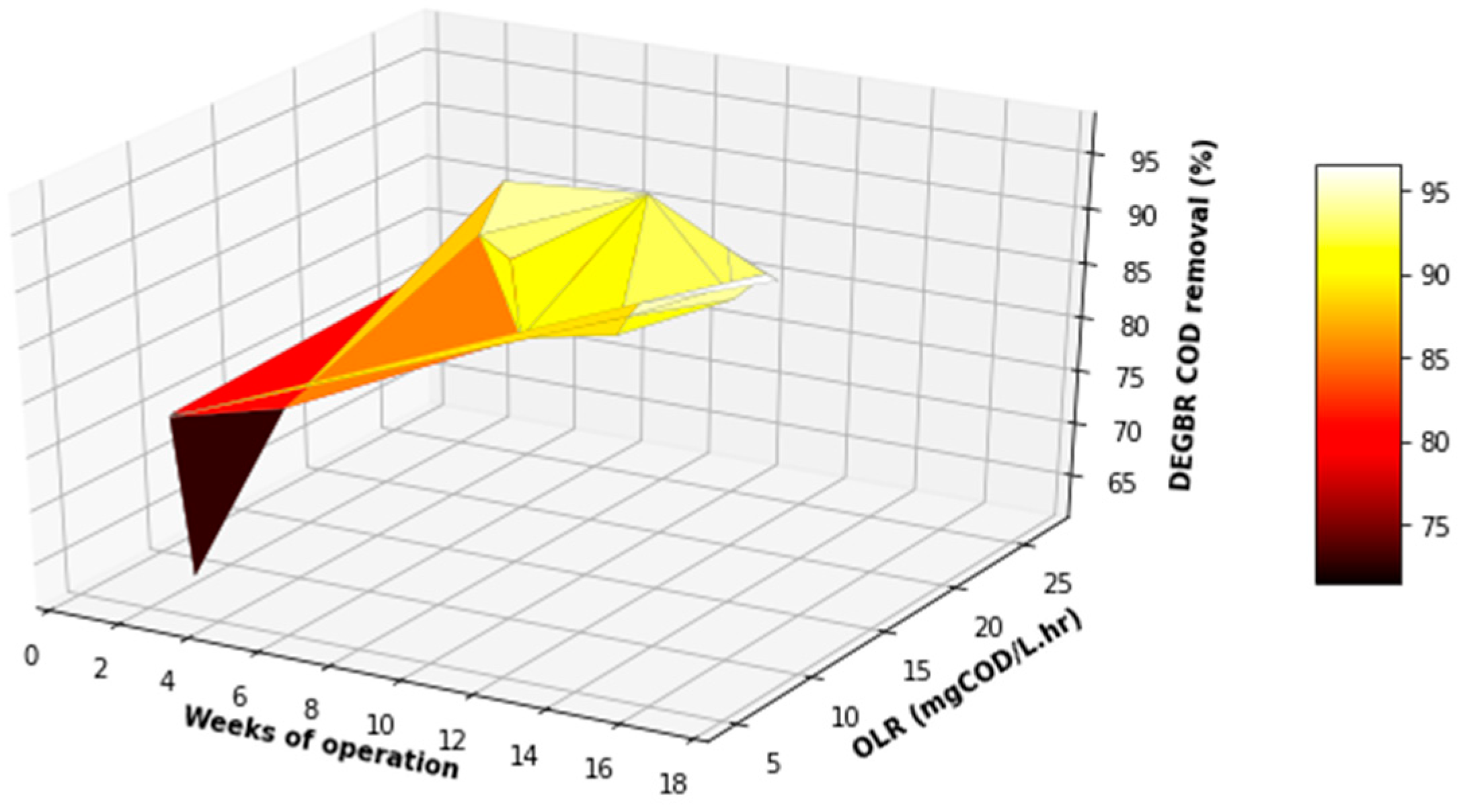

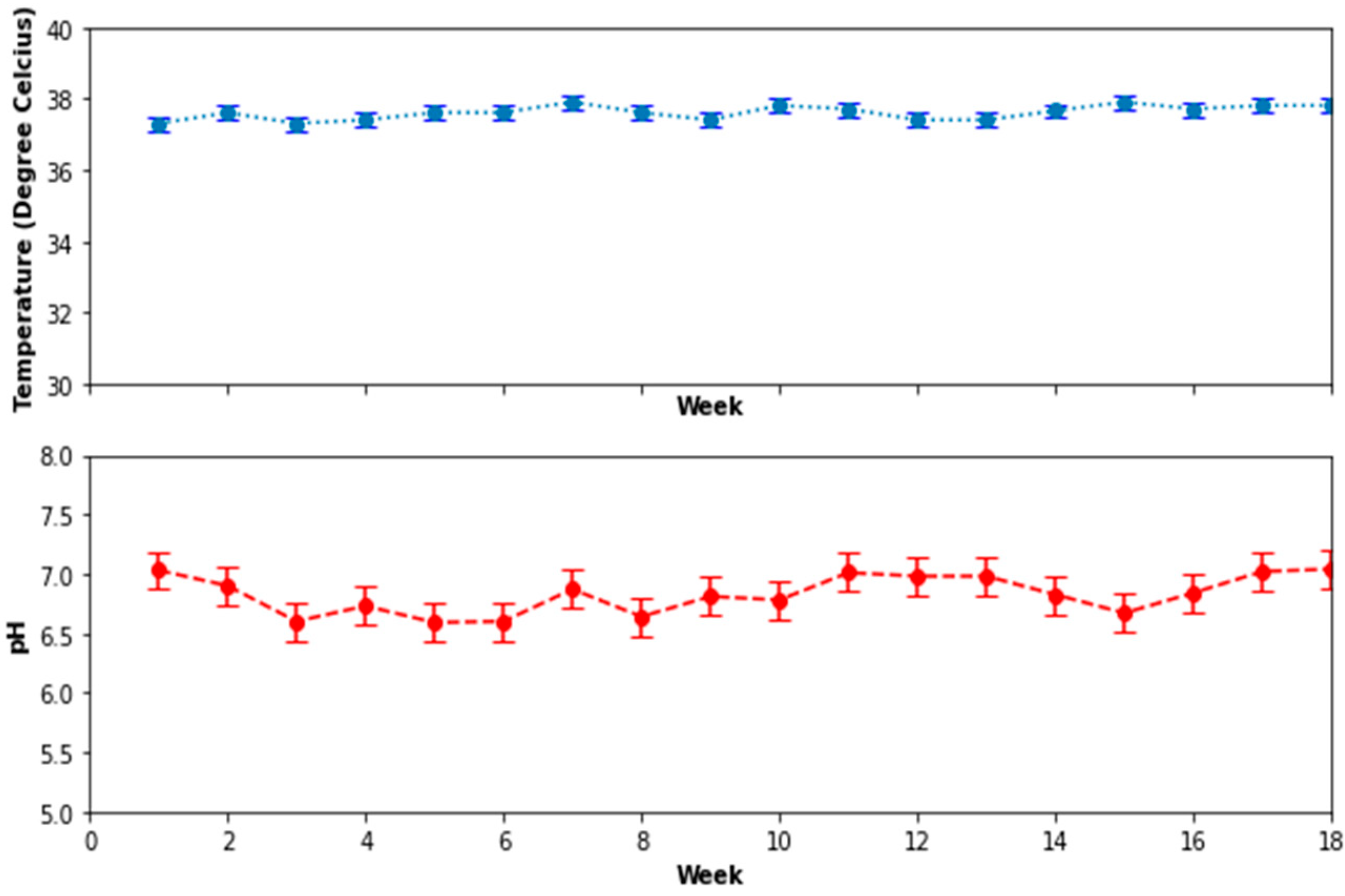


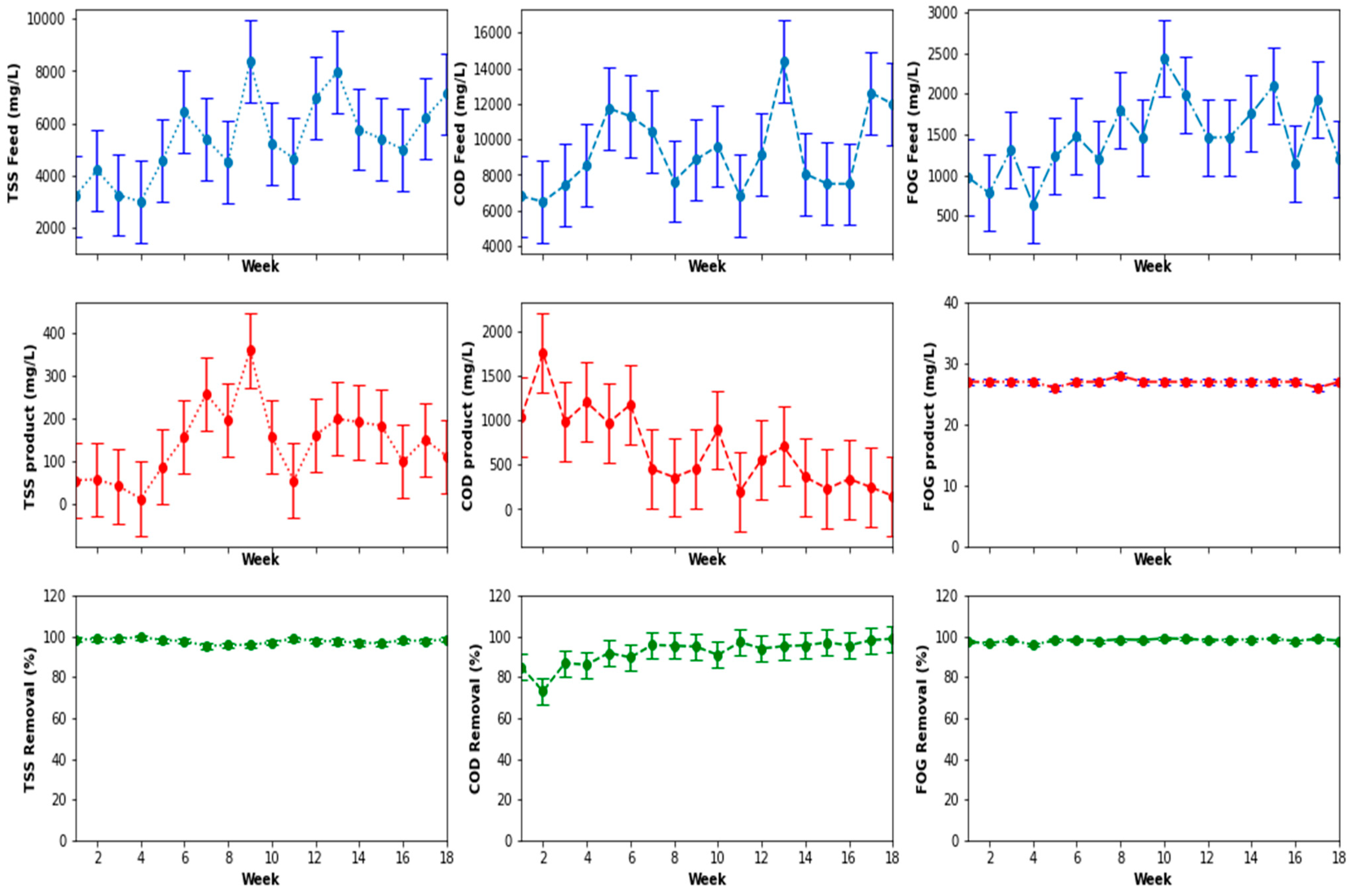
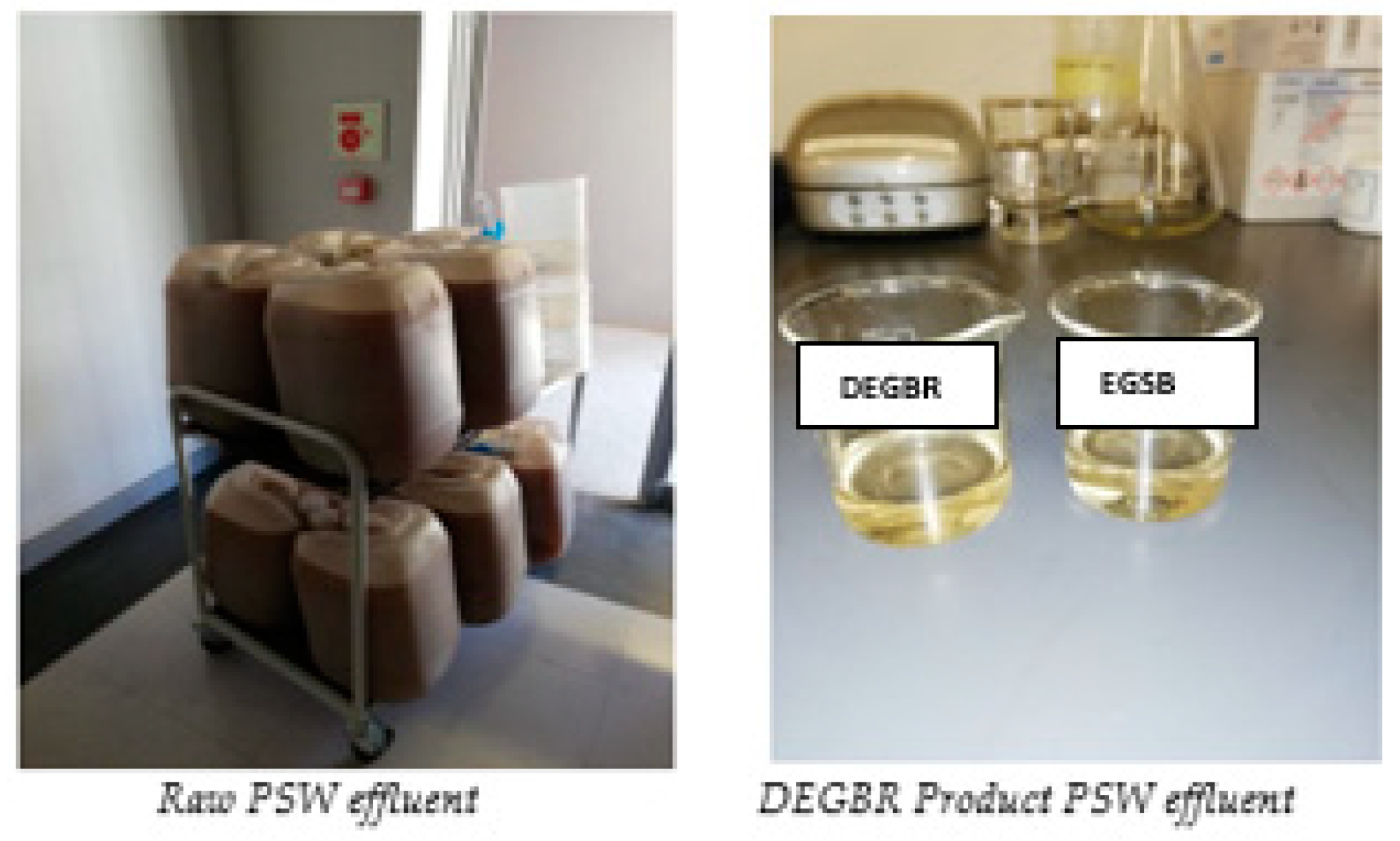
| Parameter | Inlet Feed (mg/L) | Product (mg/L) | Efficiency (η) (%) |
|---|---|---|---|
| COD | 9946 | 5896 | 39 |
| TSS | 5399 | 2392 | 56 |
| FOG | 1765 | 269 | 80 |
| Parameter | Inlet Feed (mg/L) | DEGBR Product (mg/L) | Efficiency (η) (%) |
|---|---|---|---|
| COD | 5896 | 669 | 92 ± 6.3 |
| TSS | 5399 | 185 | 97 ± 1.2 |
| FOG | 1765 | 28 | 97 ± 0.8 |
| Technology Used | Type of Wastewater | Results | Reference |
|---|---|---|---|
| Static granular bed reactor (SGBR) | PSW | 93% COD, 95% TSS, and 90% FOG | [36] |
| Up-flow anaerobic filter | PSW | 70% tCOD, VFA/alkalinity ratio: 0.12–0.34, methane content in biogas: 46 and 56% | [23] |
| Expanded granular sludge bed (EGSB) | Cooking wastewater | 72.9% COD | [22] |
| Up-flow anaerobic sludge-bed (UASB) | High fat wastewater | 91.2% COD and 98.5% FOG | [37] |
| Parameter | CCT* by-Law Limits | EHS* | DEGBR Product |
|---|---|---|---|
| COD | 5000 mg/L | 250 mg/L | 669 mg/L |
| TSS | 1000 mg/L | 50 mg/L | 185 mg/L |
| FOG | 400 mg/L | 10 mg/L | 28 mg/L |
| pH | 5.5–12 | 6–9 | 7.3 |
| Temperature | 0–40 °C | <3 a | 37.5 °C |
| VFA | - | - | 157.97 mg/L |
| Alkalinity | - | - | 888.12 mg/L |
Publisher’s Note: MDPI stays neutral with regard to jurisdictional claims in published maps and institutional affiliations. |
© 2021 by the authors. Licensee MDPI, Basel, Switzerland. This article is an open access article distributed under the terms and conditions of the Creative Commons Attribution (CC BY) license (https://creativecommons.org/licenses/by/4.0/).
Share and Cite
Dlamini, D.N.; Basitere, M.; Njoya, M.; Ntwampe, S.K.O.; Kaskote, E. Performance Evaluation of a Biological Pre-Treatment Coupled with the Down-Flow Expanded Granular Bed Reactor (DEGBR) for Treatment of Poultry Slaughterhouse Wastewater. Appl. Sci. 2021, 11, 6536. https://doi.org/10.3390/app11146536
Dlamini DN, Basitere M, Njoya M, Ntwampe SKO, Kaskote E. Performance Evaluation of a Biological Pre-Treatment Coupled with the Down-Flow Expanded Granular Bed Reactor (DEGBR) for Treatment of Poultry Slaughterhouse Wastewater. Applied Sciences. 2021; 11(14):6536. https://doi.org/10.3390/app11146536
Chicago/Turabian StyleDlamini, Derrick Njabuliso, Moses Basitere, Mahomet Njoya, Seteno Karabo Obed Ntwampe, and Ephraim Kaskote. 2021. "Performance Evaluation of a Biological Pre-Treatment Coupled with the Down-Flow Expanded Granular Bed Reactor (DEGBR) for Treatment of Poultry Slaughterhouse Wastewater" Applied Sciences 11, no. 14: 6536. https://doi.org/10.3390/app11146536






